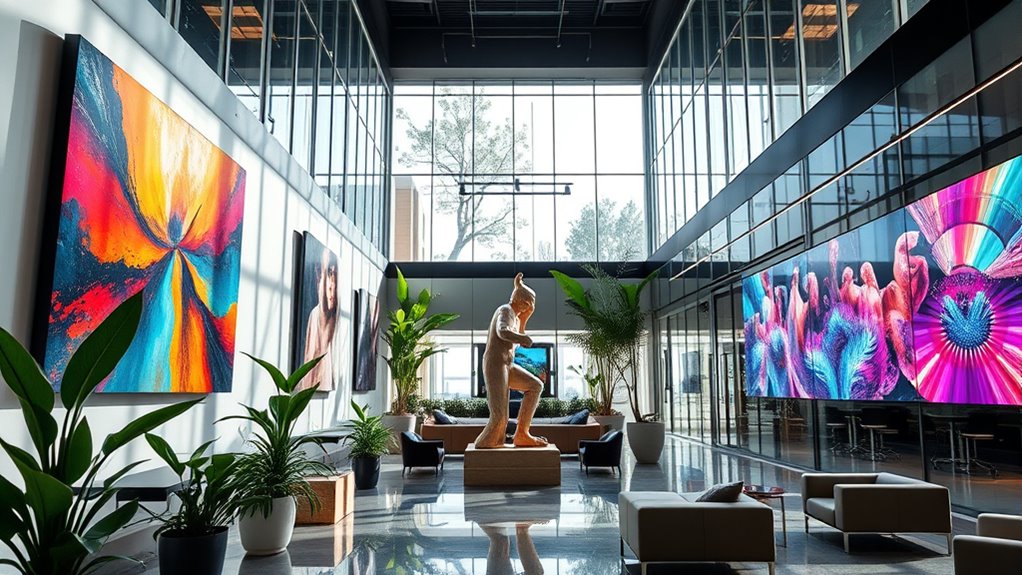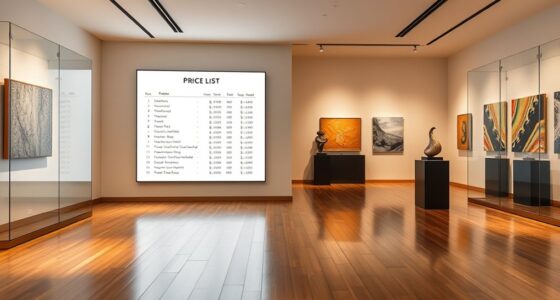In 2025, corporate art collections are more strategic than ever, enhancing brand identity and attracting talent through curated artwork that reflects core values and social issues. Digital and virtual displays are growing, making collections more dynamic and accessible globally. Art plays a key role in fostering creativity, inspiring employees, and strengthening community ties. By integrating innovation with cultural branding, organizations create vibrant spaces and powerful visual narratives—discover how these trends can transform your organization as you explore further.
Key Takeaways
- Corporate art collections serve as strategic tools for cultural branding, innovation, and demonstrating social commitment.
- Digital art and virtual galleries are expanding, enhancing accessibility and reflecting a forward-thinking corporate identity.
- Art is used to reinforce organizational values, foster creativity, and boost workplace morale and productivity.
- Collaborations with diverse artists and institutions emphasize sustainability, diversity, and innovation in collections.
- Visual assets, including digital displays, are carefully curated to shape perception and strengthen community connections.

Have you ever wondered how organizations utilize art to shape their identity and motivate their teams? In 2025, corporate art collections are more than just decorative displays; they’re strategic instruments that drive cultural branding and demonstrate dedication to innovation and community principles. When you think about art investment in this context, it’s clear that entities see value beyond aesthetics. They acknowledge that curated collections can enhance their reputation, attract leading talent, and foster a sense of shared purpose within their groups. Investing in meaningful artwork isn’t just about adding visual appeal—it’s about making a statement that aligns with the company’s mission and future vision.
Cultural branding has become a key focus for organizations aiming to distinguish themselves in competitive markets. By integrating artwork that reflects their core values and cultural identity, entities create a powerful visual narrative that resonates both internally and externally. In 2025, more enterprises are collaborating with artists and art institutions to develop collections that embody diversity, innovation, and sustainability. These pieces serve as visual ambassadors of the company’s ideals and demonstrate a genuine commitment to social and cultural issues, which can deepen stakeholder confidence and loyalty.
The shift toward more intentional and strategic art collections is also driven by the desire to foster creativity and collaboration within the workplace. Art has the unique ability to stimulate conversation, inspire new ideas, and create a positive environment. Companies are increasingly displaying artworks that provoke thought and encourage dialogue among employees, helping to build a cohesive culture rooted in shared values. This approach transforms corporate spaces into vibrant hubs of inspiration, where art directly influences workplace morale and productivity.
Moreover, in 2025, the role of digital and virtual art is expanding within corporate collections. As technology advances, companies are investing in digital art forms and virtual galleries, which allow for dynamic displays and broader accessibility. This innovation not only reflects a forward-thinking attitude but also aligns with the growing importance of digital culture and global connectivity. These investments in digital art reinforce the company’s position as a leader in embracing new trends, further strengthening their cultural branding efforts.
Ultimately, the evolving landscape of corporate art collections reveals a sophisticated understanding of how art investment and cultural branding can work hand-in-hand. It’s about more than just collecting art; it’s about strategically curating visual assets that reinforce identity, inspire teams, and communicate values to the world. In 2025, organizations recognize that their art collections are powerful tools to shape perceptions and forge meaningful connections—both within their organization and in the broader community. Recognizing the importance of color accuracy and other technological factors is essential for ensuring that the visual impact of these collections is maximized and aligns with their intended message.
Frequently Asked Questions
How Do Companies Decide Which Artworks to Acquire?
You decide which artworks to acquire by focusing on your company’s acquisition criteria, such as relevance, quality, and diversity. Artwork curation plays a key role, helping you select pieces that align with your brand identity and values. You also consider the potential for engagement and cultural impact. By evaluating these factors, you guarantee each acquisition enhances your collection and resonates with your audience.
What Are the Environmental Impacts of Corporate Art Collections?
You should consider that corporate art collections can impact the environment through sourcing and installation. By opting for sustainable sourcing, you minimize ecological harm and support eco-friendly practices. When installing artworks, choose eco-friendly materials and techniques that reduce waste and energy use. These steps help lessen your collection’s environmental footprint, aligning your company with sustainability goals while showcasing your commitment to environmental responsibility in your corporate space.
How Can Small Businesses Build an Art Collection?
Think of your small business as a blank canvas enthusiastic for expression. To build your collection, focus on local art, which symbolizes community and authenticity. Look for budget-friendly options like art fairs, student exhibitions, or online platforms that showcase affordable pieces. By curating meaningful local artworks, you create a vibrant atmosphere that reflects your brand’s values, making your space inviting, unique, and inspiring for clients and employees alike.
What Legal Considerations Are Involved in Corporate Art Acquisitions?
When acquiring corporate art, you need to take into account intellectual property rights and contractual obligations. Make certain you have proper licenses or permissions from artists or rights holders to avoid infringement. Draft clear contracts outlining usage rights, display terms, and ownership details. Also, verify that any artworks purchased or leased comply with copyright laws. Staying compliant helps you prevent legal disputes and protects your company’s reputation.
How Do Cultural Differences Influence Collection Strategies?
Think of your collection as a vibrant garden, where cultural nuances shape each bloom. You adapt your strategies by embracing artistic diversity, understanding that different cultures bring unique perspectives and values. Recognizing these differences influences your selection process, ensuring your collection reflects a global tapestry. By appreciating cultural nuances, you create a more inclusive, meaningful collection that resonates across diverse audiences, enriching your corporate environment with authentic, diverse artistic voices.
Conclusion
As you navigate the evolving world of corporate art collections in 2025, remember it’s like tending a vibrant garden—constantly growing, adapting, and flourishing. Embrace innovative trends, prioritize diversity, and leverage technology to showcase your collection’s uniqueness. By doing so, you create a dynamic space that reflects your company’s identity and values. Keep evolving with the art scene, and your collection will remain a mesmerizing, inspiring centerpiece that resonates with everyone who sees it.









